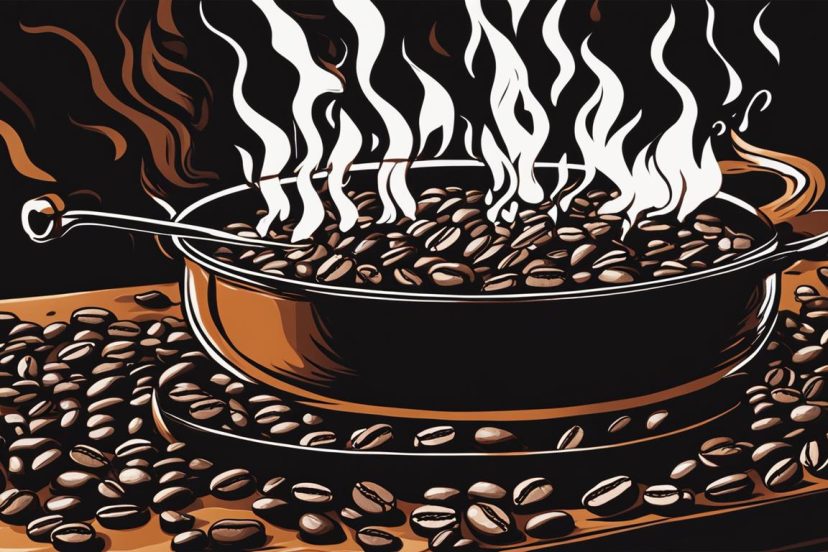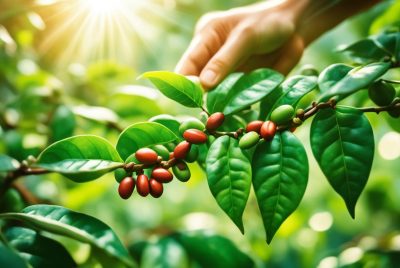What is the Effect of Roast Loss on Coffee Bean Weight?
Welcome to our article on the fascinating world of coffee roasting! In this section, we’ll be exploring the effect of roast loss on coffee bean weight. Roast loss refers to the weight reduction that occurs during the roasting process, and it plays a significant role in the coffee industry.
Page Contents
Before we dive into the details, let’s understand the basics. Green coffee beans, the raw seeds of the coffee plant, contain around 11% moisture content. This moisture contributes to their overall weight. However, during the roasting process, the beans lose most of their moisture, leading to a reduction in weight of approximately 18%.
This weight loss during roasting can have a substantial impact on coffee roasters, as it directly affects their profits. Roasters need to carefully manage moisture content to ensure consistent and predictable weight loss. Fluctuations in the green bean moisture content can lead to variations in weight loss, making quality control and maximizing profits challenging.
Your Perfect Brew Awaits with Our Premium Coffee Beans
Indulge in the rich, aromatic experience of our carefully selected coffee beans, sourced from the finest estates. Each bean is roasted to perfection, ensuring a smooth, full-bodied flavor that will awaken your senses and elevate your coffee moments.
Discover the difference quality makes - try our premium coffee beans today and elevate your coffee experience to new heights!
Key Takeaways:
- Roast loss refers to the weight reduction that occurs during the coffee bean roasting process.
- Green coffee beans typically contain about 11% moisture content, contributing to their overall weight.
- The beans lose approximately 18% of their weight as they lose moisture during roasting.
- Managing moisture content is crucial for quality control and profit optimization.
- Variations in green bean moisture content can lead to fluctuations in weight loss during roasting.
The Impact of Moisture Content on Coffee Bean Weight
Moisture content plays a vital role in determining the weight of green coffee beans. The ideal moisture content for specialty coffee ranges from 8% to 12.5%. When it comes to coffee beans, moisture content matters more than you might think. The right level of moisture ensures optimal flavor development during the roasting process. Let’s explore how moisture content influences coffee bean weight and why it is crucial for quality control.
Why Moisture Content Matters
Green coffee beans are naturally high in moisture, typically ranging from 8% to 12.5%. This moisture contributes to their overall weight. However, during roasting, beans go through a significant weight loss due to the evaporation of moisture. If the moisture content is too low, the roasted coffee may have a poor flavor profile and lack complexity. On the other hand, excessively high moisture levels create an environment conducive to mold growth and spoilage, affecting both taste and safety.
Ensuring Quality and Preventing Financial Losses
For coffee roasters, maintaining the desired moisture content in green beans is crucial for quality control and profitability. By carefully managing moisture levels, roasters can ensure consistent bean weight, flavor, and aroma. This consistency is essential for roasters to deliver a consistent product to their customers. Consistency also translates to customer satisfaction and builds brand loyalty. In addition, minimizing weight loss due to excessive moisture evaporation helps maximize profits, as roasters can sell more coffee by weight.
Proper Storage to Maintain Moisture Content
The key to maintaining the desired moisture content in green coffee beans is proper storage. Beans should be stored in a cool, dry, and well-ventilated area to prevent excess moisture absorption. It is also crucial to protect them from direct sunlight, heat, and humidity. Hermetically sealed bags can help maintain the moisture content and extend the shelf life of the beans. Regular monitoring of moisture levels using moisture meters or other tools is essential to ensure beans remain within the ideal moisture range.
Quality Control Measures
Quality control measures play a vital role in managing moisture content and ensuring consistent bean weight. Roasters should establish specifications for moisture content in their contracts with suppliers. Regular sampling and testing of incoming green coffee beans help verify the moisture content and identify any variations. This information allows roasters to adjust their roasting process accordingly and maintain consistent quality. Implementing robust quality control measures not only ensures optimal moisture content but also reduces the risk of financial losses due to poor-quality coffee.
To summarize, moisture content significantly impacts coffee bean weight and plays a critical role in quality control. By maintaining the ideal moisture range, roasters can ensure consistent flavor profiles and maximize profitability. Careful storage and regular monitoring are essential to prevent fluctuations in moisture content and maintain the desired characteristics of green coffee beans.
Factors Influencing Bean Weight Loss During Roasting
Several factors can influence the amount of weight loss that occurs during the roasting process of coffee beans. Understanding these factors is essential for quality control and optimizing the roasting process to achieve consistent results.
Roast Degree
The roast degree refers to the level of roasting, which is determined by factors such as time, temperature, and color. This plays a significant role in the weight loss experienced by coffee beans during roasting. Generally, darker roasts tend to lose more weight compared to lighter roasts. The extended exposure to heat causes the beans to undergo more moisture evaporation and undergo chemical changes, resulting in a higher weight loss.
Green Coffee Moisture
The moisture content of green coffee beans also influences the weight loss during roasting. Beans with higher moisture content will experience a greater weight loss compared to those with lower moisture content. It is crucial for roasters to monitor and control the moisture content of the green beans to achieve consistent and desirable weight loss. By establishing benchmarks for different roast degrees and monitoring moisture content, roasters can ensure predictable results and maintain quality control.
To illustrate the correlation between roast degree and weight loss, refer to the following table:
| Roast Degree | Average Weight Loss |
|---|---|
| Light Roast | 12% |
| Medium Roast | 15% |
| Dark Roast | 18% |
As seen in the table, the weight loss increases as the roast degree gets darker. This underscores the importance of considering the desired roast degree and its corresponding weight loss when aiming for consistency in the roasting process.

Visual representation of green coffee bags, an essential component in managing bean weight loss.
Conclusion
Managing and minimizing bean weight loss during the roasting process is crucial for coffee roasters. At Our Coffee Roastery, we understand the importance of controlling moisture content, adjusting roast profiles, and implementing proper storage practices to optimize profits and maintain quality control.
Consistency and careful monitoring of moisture levels are key to achieving predictable and desirable weight loss. By considering the specific characteristics of each coffee bean and adapting our practices accordingly, we ensure the best flavor and quality in the final roasted coffee product.
With a focus on coffee roasting, weight loss management, moisture control, and profit maximization, we strive to deliver exceptional coffees to our customers. By prioritizing these factors, we maintain the integrity of each bean and preserve its unique flavor profile. Whether you’re a coffee enthusiast or a coffee shop owner, you can trust Our Coffee Roastery for the highest-quality roasted coffee that meets your expectations and helps you achieve your desired results.
FAQ
What is roast loss?
Roast loss refers to the weight loss that occurs during the roasting process of coffee beans. Green beans typically contain around 11% moisture content, which contributes to their overall weight. However, during roasting, the beans lose most of their moisture, resulting in a weight reduction of approximately 18%. This weight loss can have significant implications for roasters, as it directly affects profits.
How does moisture content impact coffee bean weight?
The moisture content of green coffee beans plays a vital role in determining bean weight. The ideal moisture content for specialty coffee ranges from 8% to 12.5%. If the moisture content is too low, the roasted coffee may be of low quality, while high moisture levels can lead to mold growth and spoilage. Roasters must ensure that the moisture content falls within the desired range to maintain quality and prevent financial losses.
What factors influence bean weight loss during roasting?
Several factors can affect the amount of weight loss a coffee bean undergoes during roasting. The roast degree, including factors such as time, temperature, and color, plays a significant role. Darker roasts tend to lose more weight compared to lighter roasts. The moisture content of green coffee beans also impacts weight loss, with higher moisture content resulting in greater weight loss. Monitoring moisture levels and establishing benchmarks for different roast degrees is crucial for achieving consistent and predictable weight loss.
How can bean weight loss be managed for optimal profits?
To minimize weight loss and maximize profits, roasters can take several steps. They can ensure that the moisture content of green coffee beans falls within the desired range by setting specifications in contracts with suppliers. Adjusting roast profiles to reduce weight loss, such as opting for lighter roasts, can also be helpful. Proper storage conditions, including stable temperature and humidity, and the use of hermetically sealed bags, help maintain moisture content. Avoiding storing green coffee bags directly on the floor and periodically rotating them promotes even air circulation and prevents spoilage.
What is the importance of managing bean weight loss during roasting?
Managing and minimizing bean weight loss is crucial for coffee roasters to optimize profits and maintain quality control. By controlling moisture content, adjusting roast profiles, and implementing proper storage practices, roasters can achieve consistent and predictable weight loss. Consistency and careful monitoring of moisture levels are key to achieving the best flavor and quality in the final roasted coffee product.




